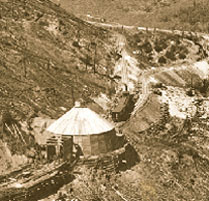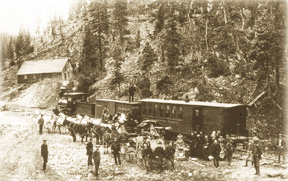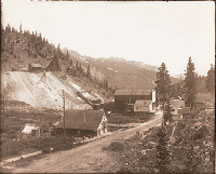Mining History – Ouray and San Juan Counties
Story by Beverly Rich for San Juan Publishing
Photos Courtesy San Juan County Historical Society. All Right Reserved.
All content © San Juan Publishing Group, Inc, All rights reserved.
[SW Colorado] The San Juan Skyway is referred to as one of the most scenic drives in America. In 1996 it was designated as one of only six All-American Roads by the US Department of Transportation. In addition to its stunning mountains and geology, the Skyway is an excursion through history. The stretch between Ouray and Silverton, known as the Million Dollar Highway, passes through the historic Red Mountain Mining District. This district contains an extensive concentration of historic silver mine sites, ghost towns, and railroad beds, most visible from the road.
 Having identified the Million Dollar Highway as a major draw for tourists in Southwestern Colorado, a region that depends on tourism for its living, a Task Force was appointed by the Commissioners of San Juan and Ouray Counties to find ways to preserve and protect the road. To accomplish this, the Task Force became partners with the Trust for Public Lands, a well-known and respected land conservation organization. Under its guidance, the Task Force asked Congress to appropriate 14.9 million dollars to buy some of the private property in the District. The funds were appropriated from the Land and Water Conservation Fund. The L&WCF was established by Congress in 1964 for the express purpose of using revenues from offshore gas and oil leases to acquire natural resource lands as a legacy for future generations. The purchased property has been added to the surrounding Uncompahgre National Forest and will be used for recreation. The Historical Societies of San Juan and Ouray Counties have partnered to stabilize several of the old mining structures that were ready to collapse, including three houses in the townsite of Ironton.
Having identified the Million Dollar Highway as a major draw for tourists in Southwestern Colorado, a region that depends on tourism for its living, a Task Force was appointed by the Commissioners of San Juan and Ouray Counties to find ways to preserve and protect the road. To accomplish this, the Task Force became partners with the Trust for Public Lands, a well-known and respected land conservation organization. Under its guidance, the Task Force asked Congress to appropriate 14.9 million dollars to buy some of the private property in the District. The funds were appropriated from the Land and Water Conservation Fund. The L&WCF was established by Congress in 1964 for the express purpose of using revenues from offshore gas and oil leases to acquire natural resource lands as a legacy for future generations. The purchased property has been added to the surrounding Uncompahgre National Forest and will be used for recreation. The Historical Societies of San Juan and Ouray Counties have partnered to stabilize several of the old mining structures that were ready to collapse, including three houses in the townsite of Ironton.
Originally known as Copper Glen, the town of Ironton began in 1883 as a supply point for the mines in the Red Mountain Mining District. The town became one of the largest in the district, with an 1890 population in excess of 300 and a variety of businesses such as hotels, saloons, restaurants and several mercantiles. The Silverton Railroad reached Ironton in 1889 and a depot was constructed at a cost of $2,500.
 Over the years several fires damaged the town, which was in decline by the turn of the last century, largely because of the silver crash of 1893. By 1910 the population was down to forty-eight. The last inhabitants, Harry and Milton Larson worked and lived in Ironton starting in the 1920s. Harry died in the 1940s but Milton continued to live alone in the town of Ironton until his death in the mid-1960s.
Over the years several fires damaged the town, which was in decline by the turn of the last century, largely because of the silver crash of 1893. By 1910 the population was down to forty-eight. The last inhabitants, Harry and Milton Larson worked and lived in Ironton starting in the 1920s. Harry died in the 1940s but Milton continued to live alone in the town of Ironton until his death in the mid-1960s.
 The discovery of the silver-rich ore at the Yankee Girl and other mines led to the creation of Red Mountain Town in early 1883. Snow concealed the swampy nature of the first townsite, so in 1885 it was moved north to firmer ground near the National Belle Mine. The town had several businesses and 500 residents. Otto Mears’ Silverton Railroad arrived on September 19, 1888. Noted photographer Thomas McKee traveled to the site to celebrate the event. The town burned in 1892, was rebuilt, burned again three years later, and was partially rebuilt. After a short economic resurgence in 1907, the population dwindled to twenty-six by 1910 and the post office closed in 1913. A 1939 forest fire destroyed most of what remained. The jail is the only remaining structure still standing in Red Mountain Town.
The discovery of the silver-rich ore at the Yankee Girl and other mines led to the creation of Red Mountain Town in early 1883. Snow concealed the swampy nature of the first townsite, so in 1885 it was moved north to firmer ground near the National Belle Mine. The town had several businesses and 500 residents. Otto Mears’ Silverton Railroad arrived on September 19, 1888. Noted photographer Thomas McKee traveled to the site to celebrate the event. The town burned in 1892, was rebuilt, burned again three years later, and was partially rebuilt. After a short economic resurgence in 1907, the population dwindled to twenty-six by 1910 and the post office closed in 1913. A 1939 forest fire destroyed most of what remained. The jail is the only remaining structure still standing in Red Mountain Town.
Photography. All images Courtesy San Juan Historical Society. All rights reserved.
Top left: Corkscrew Turntable. To accommodate the deep winter snows and turn locomotives so they would not have to go backwards down the mountain, the Corkscrew Turntable was built during the railroad’s second summer of operation.
Top right: First train arrives in Red Mountain City, September 19, 1888, pulled by the line’s sole locomotive No. 100. Railroad owner Otto Mears appears in the photo, fifth from right. (Standing next to woman in light dress. Behind them is man holding baby.) The rear baggage/chaircar, “Red Mountain,” sits in Silverton today, near the depot.
Bottom right: National Belle Mine, Red Mountain City, early 1890s. The mine is to the upper left in the photo. (Picturesque headframe is still there today.) Note the train at the depot, near the center of the photo
Beverly Rich is a life-long resident of Silverton. She is Chairman of the San Juan County Historical Society and has written numerous articles for San Juan Publishing Group and the Silverton Magazine.
References & Additional Links
Silverton Magazine. Hardrock History.
